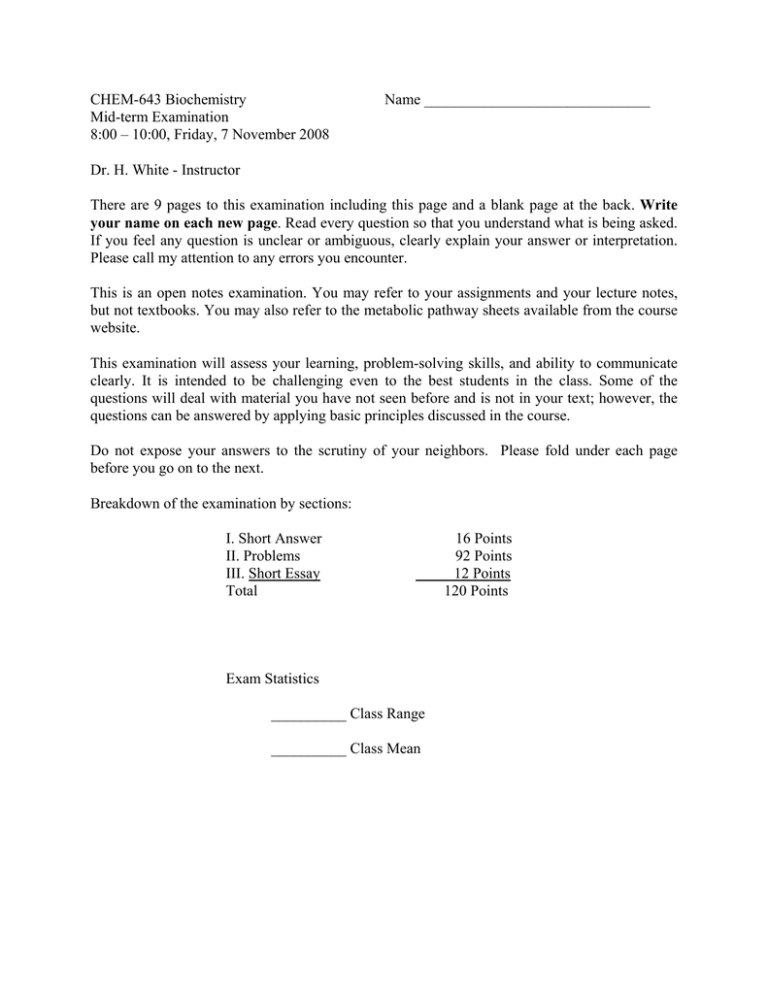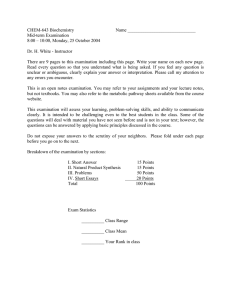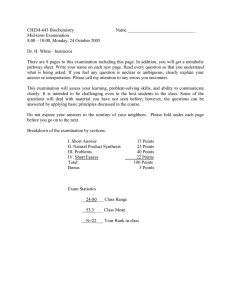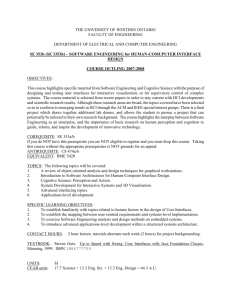CHEM-643 Biochemistry ... Mid-term Examination
advertisement

CHEM-643 Biochemistry Mid-term Examination 8:00 – 10:00, Friday, 7 November 2008 Name ______________________________ Dr. H. White - Instructor There are 9 pages to this examination including this page and a blank page at the back. Write your name on each new page. Read every question so that you understand what is being asked. If you feel any question is unclear or ambiguous, clearly explain your answer or interpretation. Please call my attention to any errors you encounter. This is an open notes examination. You may refer to your assignments and your lecture notes, but not textbooks. You may also refer to the metabolic pathway sheets available from the course website. This examination will assess your learning, problem-solving skills, and ability to communicate clearly. It is intended to be challenging even to the best students in the class. Some of the questions will deal with material you have not seen before and is not in your text; however, the questions can be answered by applying basic principles discussed in the course. Do not expose your answers to the scrutiny of your neighbors. Please fold under each page before you go on to the next. Breakdown of the examination by sections: I. Short Answer II. Problems III. Short Essay Total Exam Statistics __________ Class Range __________ Class Mean 16 Points 92 Points 12 Points 120 Points CHEM-643 Intermediary Metabolism Mid-term Examination, 7 November 2008 Page 2 Name ______________________________ Part I - Short Answer Questions (1 point each) __________________________ 1. Anaerobic glycolysis in yeast is an example of a ___. __________________________ 2. Coenzyme containing a pterin ring system. __________________________ 3. Molybdenum is required for what important metabolic process. __________________________ 4. Compound with a ΔG of hydrolysis similar to that of ATP. __________________________ 5. Number of carbon atoms in carotinoids. __________________________ 6. KDPG forms a Schiff’s base with a lysine in this enzyme. __________________________ 7. Propionyl CoA intermediate. __________________________ 8. Cobalt-containing coenzyme required for propionate oxidation. __________________________ 9. Source of carbon in nylon. is converted to this TCA cycle __________________________ 10. Diets based on corn are deficient in this amino acid. ___________________________11. Major source of energy for a 100 yard dash. __________________________ 12. How many carbons are there in the “I” of PI? __________________________ 13. How many methyl groups are there in the “C” of PC? __________________________ 14. Coenzyme associated with cleavage of C-C bonds next to a carbonyl. __________________________ 15. δ13C value for carbon in the Peedee belemnite. __________________________ 16. Organism with a mutation that results in a requirement for some nutrient. CHEM-643 Intermediary Metabolism Mid-term Examination, 7 November 2008 Page 3 Name ______________________________ Part II: Problems 1. Some bears can hibernate for six months or more. During this period they neither eat nor drink. They survive by oxidizing stored triglyceride. Glycerol generated in the hydrolysis of the ester bonds in triglycerides gets converted in two steps to dihydroxyacetone phosphate (DHAP) which likely enters the gluconeogenic pathway to produce glucose. The fatty acids generated get oxidized by the β-oxidation pathway and the citric acid cycle. a. HO (4 Points) In the large box below, draw the structure of the chiral intermediate in the two-step conversion of glycerol to DHAP. CH2OH CH2OH C C H CH2OPO3H- CH2OH 1 O 2 b. (2 Points) In the small boxes above, write the coenzymes that would be involved in each reaction. c. (4 Points) On the lines below each reaction, provide appropriate names for the enzymes catalyzing each of the reactions. d. (4 points) Estimate the Respiratory Quotient (RQ= moles CO2 produced/ moles O2 consumed) for a hibernating bear? e. (4 Points) What enables a hibernating bear live so long with out drinking? f. (5 Points) Some of the fatty acids in the hibernating bear are unsaturated, e. g. oleic acid (C18:1,Δ9). To complete the β-oxidation of oleic acid an additional enzymatic reaction needs to be employed. Predict that reaction showing the exact structures of the substrate and product. CHEM-643 Intermediary Metabolism Mid-term Examination, 7 November 2008 Page 4 Name ______________________________ NADH Fluorescence 2. The following plots present the concentrations and phase relations among certain glycolyic intermediates in yeast after an aerobic-anaerobic transition. a. (8 Points) Based on the data presented, rank order (1 to 4) the following enzyme reactions with respect to how close they are to equilibrium? (1 = closest). ___ Hexose phosphate isomerase? ___ Phosphofructokinase? ___ Fructose bispohosphate aldolase? ___ Triose phosphate isomerase? b. (4 Points) What is the basis for your answer? c. (5 Points) Estimate the equilibrium constant for the reaction you rate #1. (Estimation here means you don’t need a calculator) d. (5 Points) What do these data say about the flux and its control in the yeast glycolytic pathway? CHEM-643 Intermediary Metabolism Mid-term Examination, 7 November 2008 Page 5 Name ______________________________ 3. (10 points) Glutamate-Oxaloacetate Transaminase is a pyridoxal phosphate (PLP) dependent enzyme. The structure of PLP is shown below. Draw out the mechanism (arrow-pushing with intermediate structures) by which PLP would facilitate this reaction. O H2 O P C O O H C O OH N H CH3 CHEM-643 Intermediary Metabolism Mid-term Examination, 7 November 2008 Page 6 Name ______________________________ 4. (10 Points) The following fatty acid with a branched methyl group is found in membrane lipids from Bacillus. The biosynthesis of this fatty acid starts with a CoA ester derived in two steps from a common amino acid. Propose a two step pathway that shows the amino acid being converted to an intermediate that is then converted to the desired CoA ester. Show the three structures and identify all cofactors that would be needed for each of the two reactions. COO- Name ______________________________ Page 7 CHEM-643 Intermediary Metabolism Mid-term Examination, 7 November 2008 5. The metabolism of Threonine in E. coli is depicted in the figure below. Coenzymes and cosubstrates are omitted. The questions that follow refer to this figure with the enzymes identified by number. O COO H3C C C OH CO2 3 CH3 COOH C O H3C C C OH H CH2 4 H3C C H CH3 2 COO COO C O OHCOO CH2 H 3N C H 5 H C CH3 CH2 CH2 CH3 CH3 Isoleucine CH3 Isoleucine Biosynthesis from Threonine in E. coli COO H3N C H H C OH CH3 Threonine 1 6 NH3 COO C O CH2 CH3 Alpha-ketobutyrate 7 Threonine Catabolism in E. coli SCoA C O CH2 CH3 8 SCoA C O H3C C H COO SCoA 9 SCoA C O 10 C O H C CH3 CH2 CH2 COO COO a. (16 Points) Complete the following table by providing the names or abbreviations for any and all coenzymes and additional substrates required for the reactions. If there are no cofactors required, state “none”. Enzyme No Coenzyme(s) and cosubstrates associated with the enzyme reaction 1 2 3 4 5 6 7 8 9 10 Please provide short answers to the following b. (2 Points) The product of enzyme reaction 10 is _______________________ . c. (2 Points) Enzymes 1 and 6 are examples of __________________________ . d. (2 Points) Which reaction(s) involve(s) a rearrangement of the carbon skeleton? ___________ e. (2 Points) Estimate the Keq for reaction 9 within a factor of 10. __________________ CHEM-643 Intermediary Metabolism Mid-term Examination, 7 November 2008 Page 8 Name ______________________________ Part III Essay Question Writing reflects how you think. Among the “right answers” I will read for the following questions, some will be better than others because they show greater depth of understanding, avoid extraneous or inaccurate information, use knowledge from previous learning, provide a more logical structure, use appropriate examples, and choose words with precision. Better quality answers will receive higher marks. Therefore organize your thoughts before you write. Strive to write not that you may be understood, but rather that you cannot possibly be misunderstood. Stream of consciousness answers are rarely well organized or clearly presented. Answer only one of the two questions that follow for a maximum of 12 Points. 1. The curve at the right displays the amount of 14CO2 remaining in the atmosphere as the result of atmospheric atomic bomb testing that began in 1951 and ended in 1963. If a 100 year old tree were cut down in 2005 and the 14C content of each annual growth ring was measured and plotted, the resulting graph of 14C vs time would look much like the graph at the right. A news item published in Science this semester (12 Sept. 2008, 321, 1434) reports that, unlike the tree, the 14C/12C of molecules in different human tissues are not the same. Some reflect the carbon isotope ratio during early childhood while others reflect contemporary ratios and values in between. If you were able to analyze DNA, protein, carbohydrate, and triglycerides from different human tissues, what differences would you expect, where would you expect them, and why? 2. It was 3AM and a group of CHEM-643 students were discussing a homework problem dealing with the catabolic pathway for threonine (shown in the bottom half of figure for Problem II5 in this examination). Consider a mutant that had 10-fold excess of Enzyme 9 compared to wild type with all other enzymes at wild type levels. What would be the consequences? Betsy: I think the concentration of the substrate and product of the enzyme would also incease 10 fold. George: That’s not so, the concentration of reaction product would increase, but the substrate would stay about the same. Glenn: If you ask me, you’re both wrong. The concentration of substrate and product would change little, but the flux in the pathway would be increased several fold. Please help set the students straight on what to expect and the reasons in this example? CHEM-643 Intermediary Metabolism Mid-term Examination, 7 November 2008 Page 9 Name ______________________________






